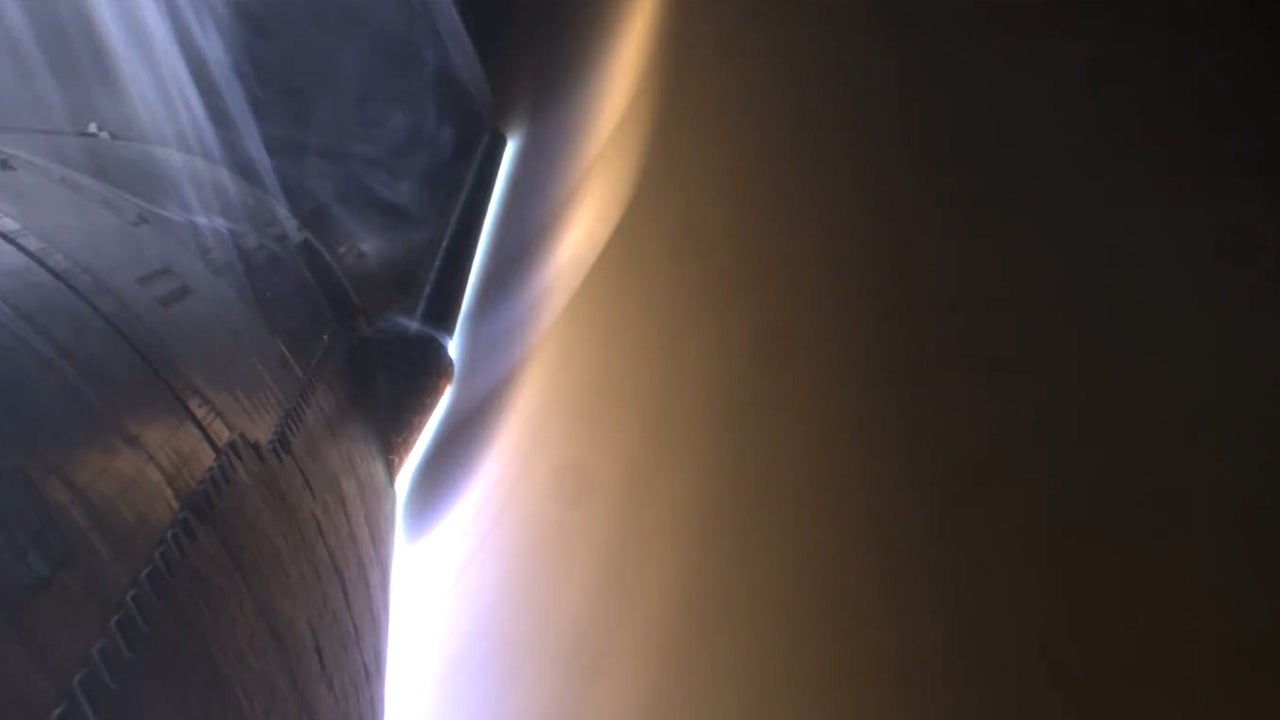SpaceX has completed the fourth test flight of its leviathan Starship spacecraft and Super Heavy booster, which saw the uncrewed test vehicle brave a punishing and visually spectacular descent through Earth's atmosphere, after its powerful first stage rocket performed its first successful controlled water landing in the Gulf of Mexico.
The near 400 ft tall rocket consists of an enormous Super Heavy booster first stage, upon which the sci-fi form of the Starship upper stage is stacked. Super Heavy alone plays host to an impressive 33 Raptor engines, which are capable of generating over 16 million pounds of thrust at launch, while Starship itself features a further six raptor engines, three of which are optimized for use in the vacuum of space.
SpaceX hopes that the power, flexibility, and fully re-usable design of the Starship launcher will one day make it a revolutionary force in spaceflight and form a key element in humanity’s ongoing mission to return to the Moon, before carving out a path to Mars. However, in order to do that, the Hawthorn-based company will first need to prove that its vehicle can reliably survive launch, ascent, orbital operations, re-entry, and landing.
Slow motion liftoff of Starship on Flight 4 pic.twitter.com/9itFbrfxW7
— SpaceX (@SpaceX) June 6, 2024
To that end, Elon Musk’s aerospace company has engaged in an intensive campaign of flight tests orchestrated from SpaceX’s Starbase launch site In Boca Chica, Texas. Each of the three prior missions launched to date have resulted in the loss of the Starship spacecrafts in a fiery conflagration, which necessitated the completion of a comprehensive ‘mishap investigation’ into the cause of the failures before the Federal Aviation Administration (FAA) would grant a launch licence for the next test.
This aggressive approach of testing to destruction has netted SpaceX scientists and engineers masses of performance data, which has been used to swiftly iterate on the launcher’s design, moving both booster and spacecraft closer to becoming fully operational.
On its third suborbital outing in March earlier this year the booster was able to successfully push its Starship upper stage to space on a sub-orbital trajectory, before the spacecraft was ultimately lost during its fiery descent back through Earth’s atmosphere after losing control of its orientation. The Super Heavy booster also failed to survive the mission, with a number of Raptor engines failing to ignite during a powered water landing attempt.
We intentionally placed one thin heatshield tile and removed two tiles completely from the Ship to measure how hot things get without tiles in those locations, while also testing some thermal protection options pic.twitter.com/jy7yKc5XvV
— SpaceX (@SpaceX) June 6, 2024
For Starship’s fourth test flight on June 6, SpaceX shifted its focus away from ascent and towards reusability and survivability through atmospheric re-entry. Survival during this phase of the mission was entirely dependent on the performance of Starship’s heat shield, which is made up of a mosaic of honeycomb tiles arrayed along the ‘bottom’ of the spacecraft, and on other areas where the extreme heat of re-entry will be felt the most.
During today’s outing, SpaceX engineers intentionally placed a thin heatshield tile on the underside of Starship and removed two others entirely in order to measure how hot the spacecraft would get in these areas if the protective material was absent.
SpaceX has also spent the time following the third test flight making a number of other hardware and software upgrades to both the Super Heavy booster and Starship spacecraft. Among the overhaul were significant changes to the valves feeding the upper stage attitude control thrusters, which were thought to have become partially blocked during the third test, leading to the loss of control.
Starship’s Fourth Test Flight
At 7:50 a.m. CT on June 6, Super Heavy’s host of Raptor engines ignited to challenge Earth’s gravity and heave the gargantuan rocket into the morning sky above the Boca Chica launch site, marking the start of SpaceX’s fourth Starship test flight.
Liftoff of Starship! pic.twitter.com/2Z1PdNPYPG
— SpaceX (@SpaceX) June 6, 2024
Two minutes and 50 seconds into the flight, the Starship upper stage fired a number of its Raptor engines while it was still in contact with the booster - a manoeuvre known as ‘hot staging’ - in order to push Super Heavy away and ensure a clean separation. Super Heavy went on to perform a boost back burn before performing a spectacular powered soft water landing in the Gulf of Mexico.
Super Heavy has splashed down in the Gulf of Mexico pic.twitter.com/hIY3Gkq57k
— SpaceX (@SpaceX) June 6, 2024
Starship meanwhile continued to burn its engines for a little less than six minutes, before cutting them to coast to a height of 214 km above Earth’s surface, where the improved attitude control elements allowed the spacecraft to retain control over its orientation. All that remained was to let gravity usher in yet another high-stakes atmospheric re-entry.
Starship coasting in space pic.twitter.com/kphbuXuEMr
— SpaceX (@SpaceX) June 6, 2024
A little over 45 minutes after launch, Starship’s Earth-facing side became visibly wreathed in glowing plasma as the hypersonic spacecraft compressed the thickening atmosphere around it. The entirety of the dramatic descent was streamed in real time by onboard cameras relaying data via Starlink satellites, bar a few losses of signal brought on by the surrounding plasma. Over the course of 20 minutes, viewers watched as Starship’s front right control fin was shredded by the intense heat of re-entry, even as the camera lens became cracked and coated in debris.
Peaking heating. Starship on a good entry trajectory pic.twitter.com/H0Gv6hyvt2
— SpaceX (@SpaceX) June 6, 2024
With the view obscured, its impossible to know how much of the spacecraft actually survived the tumultuous journey through Earth’s atmosphere. However, telemetry from Starship - and glimpses of the valiant actuator fin through the damaged onboard camera - revealed that the spacecraft was seemingly able to ignite its engines to attempt a landing burn upon nearing the surface of the Indian Ocean.
This is wild. Views of SpaceX's Starship plunging through the atmosphere as the wing starts to burn up. pic.twitter.com/wHvv6bAoNP
— Christian Davenport (@wapodavenport) June 6, 2024
The SpaceX Starship re-entry is wild! Vivid plasma, even the flap started to break up & dissolve from the extreme heat. But it survived and splashed down in Indian Ocean. #SpaceX #Starship #rocket #SpaceXSarship pic.twitter.com/cBWUVGWyC1
— AC (@ACinPhilly) June 6, 2024
Regardless of the state of the spacecraft, today's mission can only be considered an overwhelming success, and will have provided SpaceX with a wealth of telemetry and heat shield performance data that will help engineers iterate on Starship's design to help prepare for its fifth test flight, which will almost certainly follow later this year. Space X is also working to construct a second ‘Mechazilla’ launch tower at its Boca Chica launch facility, and is looking to construct two more towers at Cape Canaveral in Florida, which should help improve the company's launch cadence in the coming years. The current tower is equipped with a set of pincer-like 'arms', which could be used to catch Super Heavy boosters during future precision landings.
Starship landing burn startup just visible through soot and debris pic.twitter.com/4KgAYdpA2q
— Michael Sheetz (@thesheetztweetz) June 6, 2024
Musk revealed in a recent presentation that SpaceX is looking to begin work on six more Starships and Super Heavy boosters this year. Furthermore, the X owner revealed that an orbital Starship re-fuelling demonstration could occur sometime next year, and that he would like to see at least two controlled and accurate ocean landings with the spacecraft before any attempt to perform a Starport landing. An attempt to catch the Super Heavy booster using the Boca Chica launch tower's arms could potentially come even sooner. “I think we should try to catch the booster with the mechazilla arms next flight,” commented Musk in an X post in the wake of today’s successful test flight.
For more space news, why not read up on the first crewed flight of Boeing’s Starliner spacecraft, or discover what it would look like to fall directly into a supermassive black hole, courtesy of a new NASA supercomputer simulation.
Image credit: SpaceX
Anthony is a freelance contributor covering science and video gaming news for IGN. He has over eight years experience of covering breaking developments in multiple scientific fields and absolutely no time for your shenanigans. Follow him on Twitter @BeardConGamer






